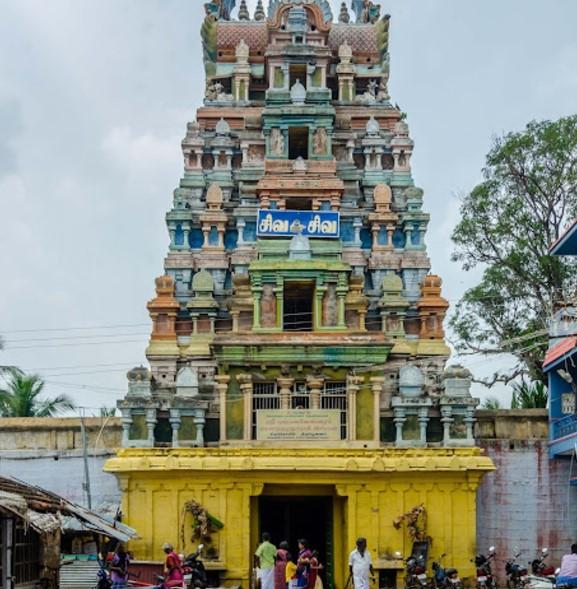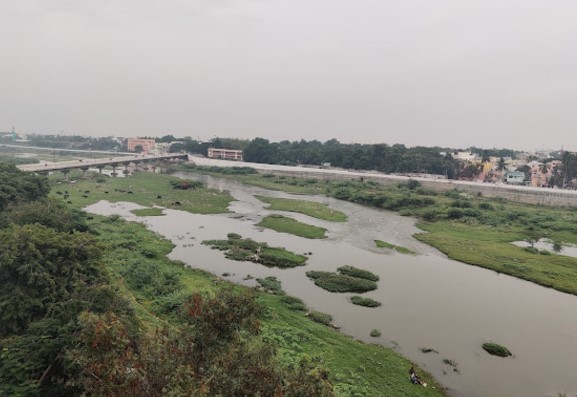Thirupuvanam is also called Pushpavana Kasi, Lakshmipuram, Bhaskara Puram, Brahmapuram, Rasavadapuram and Pitru Moksha Puram.
Pushpavaneswarar Temple (also known as Poovananathar Temple or Pithru Muktheeswarar Temple) is a revered Hindu shrine dedicated to Lord Shiva, located in Thirupuvanam town in Thirupuvanam Taluk, Sivaganga District, Tamil Nadu.
The presiding deity, Pushpavaneswarar (also called Poovananathar), is associated with the name Pithru Muktheeswarar due to the temple’s significance in granting liberation to ancestors. The goddess, Soundaryanayaki (also known as Minnanayal or Azhagiya Nayagi), is the consort of Lord Shiva.
This temple is one of the 276 Paadal Petra Sthalams, sacred Shiva temples glorified in the early medieval Thevaram hymns composed by the Nayanmar saints. It is specifically the 255th Devaram Paadal Petra Shiva Sthalam and the 11th in the region of Pandya Nadu. The temple is also significant as one of the 44 Paadal Petra Sthalams where the three great saints, Thirugnana Sambanthar, Appar, and Sundarar, sang their devotional hymns, and it is a noted Thirupugazh Sthalam, where Lord Murugan is praised in the Thirupugazh hymns by the 15th-century saint Arunagirinathar.
The temple is historically important for being the site of one of Lord Shiva’s 64 Thiruvilayadals (divine plays). Situated on the southern banks of the Vaigai River, the temple is a center of spiritual importance.
The temple's rich history, association with revered saints, and the divine plays of Lord Shiva make it a significant pilgrimage site for devotees.
TEMPLE HISTORY:
There lived in Tirupuvanam a dancer named Ponnaiyal by name. As a staunch devotee, she spent all her earnings from the dancing programmes in feeding Shiva devotees. She had a desire to sculpt Lord Poovananathar in pure gold. To fulfill her desire, Lord came in the guise of a siddha and advised her to melt all the brass, lead and copper articles in the house at night which will turn into gold. The dancer followed the advice of the Siddha and her joy knew no bounds to see adequate gold to make the idol of the Lord. With the gold she got through the alchemy miracle, the dancer made out a beautiful idol of the Lord and in her ecstasy, she embraced the idol and kissed it on the cheek. The nail symbol of Ponnaiyal is visible on the procession deity.
Divine Play and the Story of Ponnaiyal:
The temple is also linked to one of Siva's 64 divine plays (Tiruvilaiyadals), which is recorded in the Koodal Kandam of the Paranjothi Munivar's puranam. The story tells of Ponnaiyal, a devoted dancer who aspired to create a golden idol of Siva but lacked the resources. Siva, pleased with her devotion, appeared in the form of a craftsman named Rasavata. He instructed her to melt the only metals she had—iron and brass. To her astonishment, the metals turned into gold overnight, and Rasavata sculpted the golden murti of Siva. Ponnaiyal was so moved by the beauty of the idol that she pinched its cheeks, leaving her nail marks. The same utsava murti of Siva with these marks is still used in the temple today.
The Parvati and Siva Connection:
The temple is also associated with Parvati's penance to expiate the sin she incurred after the dispute with her father Daksha. She worshipped Siva here, where He appeared under a Parijata tree, symbolizing the power of her devotion. The main deity of the temple is the Swayambhu Lingam, worshipped by celestial beings such as Vishnu, Brahma, Suryan, Chandran, Yama, and Nala, adding to its spiritual significance.
Agastyar and the Ocean:
According to the Padma Puranam, the sage Agastyar drank the oceans to expose the hidden asuras. As part of the temple's sthala puranam, it is believed that Agastyar drank the water from the Manikarnika Teertham of the temple, which enabled him to drink up the entire ocean, demonstrating the sacredness of the temple’s waters.
Thiruvilayadal of Lord Shiva at Thirupuvanam
- Thirupuvanam is the site of one of the 64 Thiruvilayadals (divine plays) of Lord Shiva, specifically the 36th Thiruvilayadal known as Rasavatha (alchemy). According to the Thiruvilayadal Puranam, a dancer woman named Ponnaiyal, who lived in Thirupuvanam, was a devout follower of Lord Shiva. She used her earnings from dancing to feed Shiva’s devotees but desired to sculpt an idol of Lord Poovananathar in pure gold. Lacking the funds, she prayed sincerely to Lord Shiva.
- Pleased with her devotion, Shiva appeared in the form of a metallurgist (Rasavathi) and instructed her to melt brass, copper, and lead articles in her house. The next morning, she discovered that the metals had turned into gold, which she used to create a beautiful idol of Shiva. Delighted by its beauty, she pinched the idol’s cheeks, and it is believed that the pinch mark remains on the idol to this day. The idol, known as the Utsava idol, is still worshipped in the temple, and an idol of Ponnaiyal can be seen in the front mandapam.
- Thirupuvanam Holier Than Kasi
- In a significant legend, Dharma Yagnan, a Vedic scholar, was carrying the ashes of his father, Veda Sharma, to immerse them in the Ganga river. During his journey, he and his disciple stopped at Thirupuvanam. While bathing in the Manikarnigai Theertham, Dharma Yagnan accidentally dropped the pot containing the ashes into the water. Upon retrieving it, he was astounded to find that the ashes had turned into lotus flowers. After consulting the sages, he learned that his father had attained Moksha.
- Lord Shiva, pleased by Dharma Yagnan's devotion, appeared to him in the form of Rishabaroodar and blessed him. As a result of the miracle with the ashes, Thirupuvanam became known as a place holier than Kasi, with the proverb stating that it is "more revered than Kasi." Those who cannot travel to Kasi to immerse the ashes of the deceased often do so in the Vaigai river at Thirupuvanam, lighting the Moksha Deepa for their departed souls.
- Nandi's Position at Thirupuvanam
- A notable feature of the Thirupuvanam temple is that the Nandi, the bull vehicle of Lord Shiva, is placed slightly away from its usual position. According to the legend, when Nayanmar Tirugnanasambandar visited this place, he found Shivalingas in every particle of river sand, making it impossible for him to walk. He stood on the opposite bank of the Vaigai river and sang his pathigams. Nandi, who was obscuring Shiva from his view, was then asked by Lord Shiva to move aside. Even today, Nandi remains slightly away from its usual position to grant devotees an uninterrupted view of Lord Shiva.
Moovar Mandapam
Thirupuvanam is also famous for the Moovar Mandapam, which marks the place where the three great Nayanmars — Thirugnana Sambandar, Appar, and Sundarar — worshipped Lord Shiva during their visit. They could not walk on the river’s sandy Shivalingas and therefore sang their devotional hymns from the opposite bank of the Vaigai River. The place where they had darshan is now called the Moovar Mandapam, located near the Madapuram Bhadra Kaliyamman Temple. Thirupuvanam is one of the 44 Paadal Petra Sthalams where the Moovar (the trio of Nayanmars) rendered their pathigams.
Pushpavaneswarar and the Parijatha Tree
Another prominent legend is that of Sati (Parvati), who incurred a sin for arguing with Lord Shiva regarding attending her father Daksha’s Yagna. To expiate her sin, she came to Thirupuvanam, sat under the Parijatha tree, and performed intense penance. Pleased with her penance, Lord Shiva appeared as a Shiva Linga beneath the tree and dispelled her sin. Since Shiva emerged under the Parijatha tree, he came to be known as Pushpavaneswarar, and the place became known as Pushpavanam (later Thirupuvanam).
Manikarnika Theertham and Sage Agasthya
Manikarnika Theertham in Thirupuvanam is linked to another legend involving Sage Agasthya. According to the Padma Puranam, Sage Agasthya drank the waters of the oceans to expose the Asuras who were hiding there. It is said that he first drank the water from the Manikarnika Theertham, which gave him the power to consume the entire ocean water and reveal the Asuras.
Other Worshippers of Lord Shiva
Many revered deities and sages are believed to have worshipped Lord Shiva at Thirupuvanam. Among them are Lord Vishnu, Lord Brahma, Goddess Lakshmi, Surya, Chandra, Yama, Dharma Yagnan, Thiranasanan, Sage Narada, Sage Agasthya, Sage Gautama, Gorakka Siddhar, King Nala, Thirugnana Sambandar, Appar, Sundarar, Manickavasagar, Karuvur Thevar, Paranadeva Nayanar, Pattinathu Pillaiyar, and Sekkizhar.
The Significance of the Temple: The temple in question is located in a place historically known by various names, including Pushpavanakasi, Pithur Moksha Puram, Baskara Puram, Lakshmipuram, Brahmapuram, and Rasavatha Puram. These names reflect the temple's prominence in spiritual and historical contexts.
Darumagnanan’s Story: One of the central stories from the Sthala Purana (temple history) involves Darumagnanan, a scholar who was carrying his father’s ashes from Vervanam (on the banks of the Thamirabarani River) to the Ganga for immersion. While stopping at this temple, Darumagnanan took a bath in the Manikannigai theertham (holy tank). An accident occurred when he tripped, causing the pot containing his father’s ashes to fall into the water. To his amazement, the ashes had transformed into lotus flowers, signifying that his father had attained moksha (liberation). After sharing this experience with the sages at the temple, Darumagnanan prayed to Lord Shiva, who appeared in the form of Rishabarooder (a bull-headed deity) and blessed him.
Ponnanayal’s Devotion: Another key story revolves around Ponnanayal, a dancer and ardent devotee of Lord Shiva. She spent all her earnings on annadhanam (feeding the devotees) and dreamed of making a golden idol of Lord Shiva for worship. Unable to afford the gold due to her previous charitable spending, she prayed to Lord Shiva, who, in the form of a Siddhar (mystic), appeared and instructed her to melt the vessels she had at home, which would magically turn to gold. After receiving this divine blessing, Ponnanayal was able to create the golden idol, and in her admiration of its beauty, she pinched the idol's cheeks. The marks from this pinch can still be seen on the idol today. This event is recorded in the 36th Thiruvilayadal Puranam.
Alchemy and Divine Intervention: The incident of Ponnanayal’s creation of the golden idol is tied to the concept of Rasavatham (alchemy), which is a recurring theme in Tamil literature. Lord Shiva's magical intervention here points to his divine role in alchemy, where he transformed common materials into precious ones.
Thiruvilayadal Puranam Verse: The text also references a verse from the Thiruvilayadal Puranam (a text describing Lord Shiva’s divine play and miracles), detailing the interaction between the Siddhar (who is identified as Lord Shiva) and Ponnanayal. This verse speaks of Lord Shiva's divine power to transform metals into gold, which ultimately helped Ponnanayal fulfill her wish.
Pinch Marks and Sacred Symbols: The marks left by Ponnanayal’s pinch, along with other sacred symbols like Jada Mudi (matted hair) and the Trishul (trident), are said to be visible on the idol during the aarti (worship ceremony). These features are mentioned in the Thevaram (hymns) by Thirunavukkarasar Swamigal, who poetically describes the marks and the idol’s beauty.
ADMINISTRATION:
The Temple is maintained and administered by the Hindu Religious and Endowment Board of the Government of Tamil Nadu.

